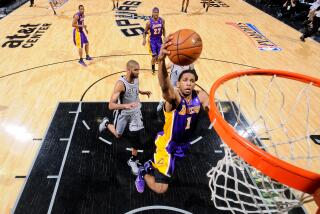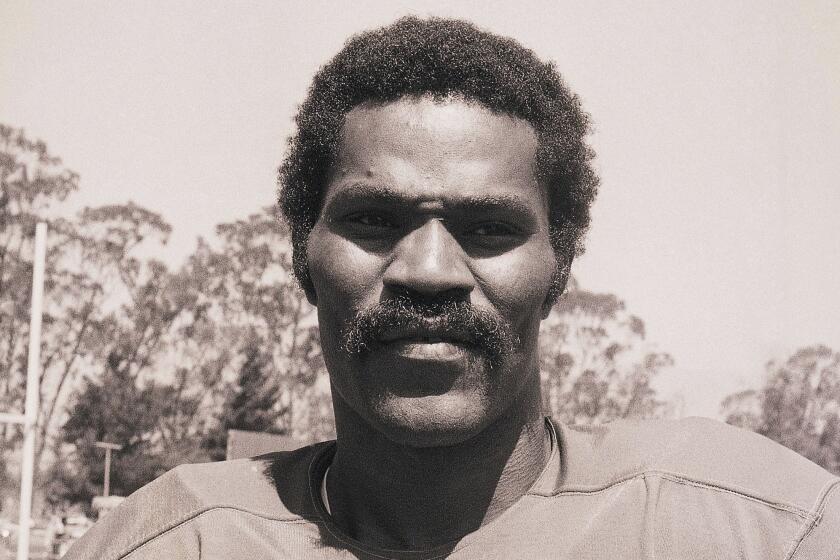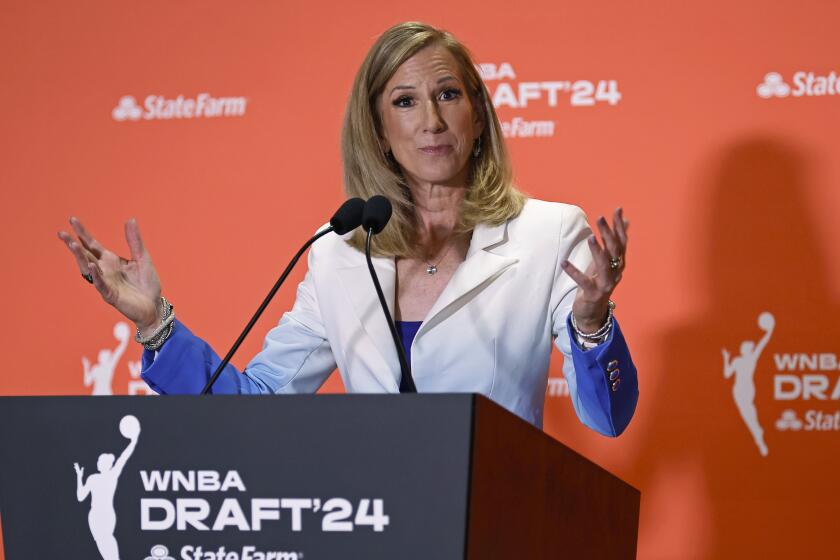Indianapolis 500 Key: Just Let the Air Out of Tires
The talk before Sunday’s Indianapolis 500 was of engines and chassis and strategy. The talk afterward was of tires.
The one piece of equipment that everyone takes more or less for granted was the determining factor in Arie Luyendyk’s surprising victory.
Emerson Fittipaldi, the defending champion who set a fast early pace that made things boring, finished third because of blistering tires.
Bobby Rahal, another former champion, couldn’t maintain a late-race charge and had to settle for second because he was worried about blistering his tires.
Other contenders were victimized as well--Rick Mears early and Al Unser Jr. later, finishing fifth and fourth, respectively.
And so Luyendyk, with no tire problems to slow him and a surprisingly strong car to carry him, drove smartly when the opportunity presented itself.
Tires? Tires are supposed to be like umpires--efficient and unobtrusive. Who would have thought the problem could be tires?
Certainly not Goodyear, which makes the radials the Indy cars race on. Goodyear implied that the manufacturer’s warranty had been voided by misuse.
Said Leo Mehl, Goodyear’s director of racing: “Over the years, teams here have learned that the quick way around this Speedway is to run the car loose. One trick that helps them to do that is to over-inflate the right rear tire, which causes the tread to crown a bit in the middle of the tire.
“This strategy, combined with the hottest day we have had this month and a record race pace, led to overheating the right rear tire and blistering along the center line of the tread.”
According to Goodyear, engineers recommended cold-tire inflation to 36 pounds per square inch, which, because of expansion, would have the tires running hot at 45-46 p.s.i. The engineers said every blistered tire exceeded 50 p.s.i.
Apparently, Luyendyk’s crew kept a close eye on the pressure gauge. He had no blistering problems and won at a record average speed of 185.984 m.p.h.
Drivers tended to be noncommittal about the cause of the blistering right rear tires, but nobody simply put it down to high speed on a hot track. Steve Newey, Rahal’s race engineer, pretty much agreed with Goodyear’s assessment, saying that his crew caught the problem before it got to the blistering stage.
“Bobby had trouble, but we compensated for it very quickly by lowering the right rear tire pressure by about 6 p.s.i. That really helped us and saved the tires.”
But not until after the major damage had been done.
At a crucial point in his race--leading at 141 laps of the 200-lap event--Rahal came in for fuel and tires. The right rear he got in that set of tires, though, was not up to the task. It didn’t blister, but it did affect his car’s handling and Rahal had to back off slightly.
That was all the opportunity Luyendyk needed. He passed Rahal for the lead on lap 167 and held it right on through another round of pit stops.
And on his final stop, Rahal, spooked by his own tire-related handling problem and others’ blistering, went not with a new set, but instead with one he used earlier in the race, as did Fittipaldi, choosing reliability over a possible better bite.
“That might have been a mistake,” Rahal said. “But on the other (new) set, I had bad under-steer. The car pushed badly (drifted out of the driving line in the corners). I was concerned about blistering. After my last pit stop I ran some of my fastest laps of the race and closed up, but I couldn’t keep it going.”
Before Rahal came to grief, though, Fittipaldi showed him the meaning of the word.
He dominated the first half of the race, then spent the second half wondering what was going on.
“The car was perfect,” he said of the machine he calls “the woman in red.”
“I just had a surprise when I blistered the rear. My car was pushing, and the next lap I had a blister--a big surprise to me.”
And that was just the start of his problems. In 36 laps, Fittipaldi pitted three times, went through two sets of tires and fell from first to third.
“On the second set, I lost a piece of the tire,” Fittipaldi said. “The rear tread came off, and I had a bad vibration. I had to come in again, and that cost me the race. What I did in the end, I went back to a used set that we had run in the race before and that was beautiful. I had no problems. I did my quickest laps at the end on used tires.”
By then, though, Fittipaldi had pitted once more than Luyendyk or Rahal and was a lap down, an incongruity he remedied just before he finished, passing Luyendyk to get back on the lead lap.
“I would say the car was running as good as last year’s (winning) car,” he said. “When I came out of the car (at the end of the race), I had the adrenaline pumping hard and was very disappointing. But it was beyond my control, what happened, and that’s racing.
“It looked very similar like last year (in the early stages). The car was very quick through traffic. I could run different lines--low lines and even outside--and then have no (problem) through traffic. It was very big surprise when I had the first blister.”
Fittipaldi even went so far as to allow himself to think that he might be on his way to a second consecutive victory here.
“When I was over 100 laps I was feeling very confident that as long as I made no mistake and the balance stayed like that . . . The car was beautiful. I mean, you can lose the race in the last 100 yards, but I was feeling very comfortable.
“The woman in red was beautiful today. She just needed a different pair of shoes.”
More to Read
Get our high school sports newsletter
Prep Rally is devoted to the SoCal high school sports experience, bringing you scores, stories and a behind-the-scenes look at what makes prep sports so popular.
You may occasionally receive promotional content from the Los Angeles Times.






